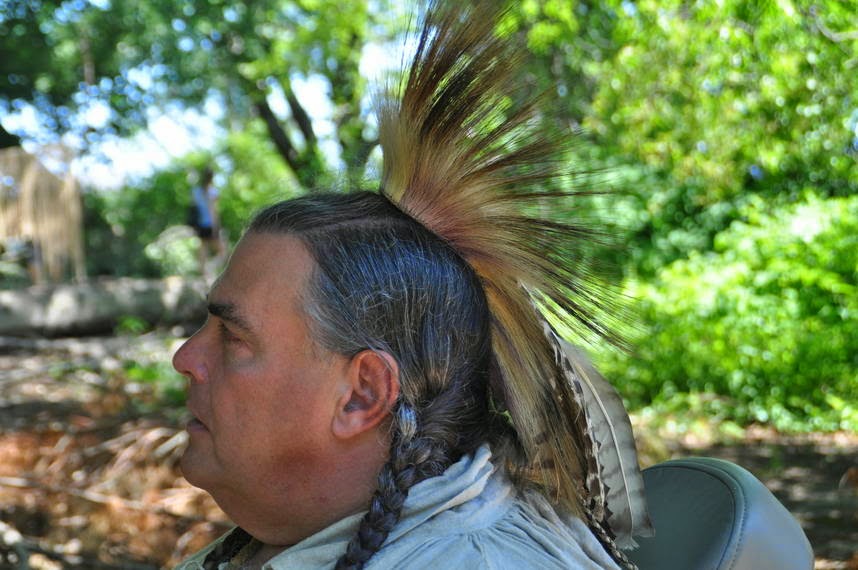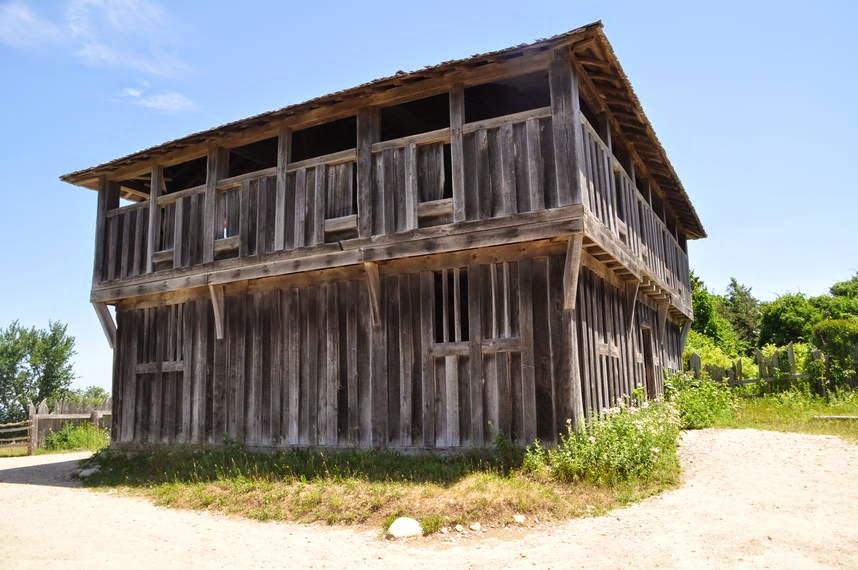July 6
Hey there Campers;
What
a beautiful sunny day. We went to the Plimoth Plantation. Yes that is the
correct spelling for the plantation. There is a the Wampanoag Indians Homesite
that recreate how the Indians lived. They were the first people in the area. The area had true descendants of the tribe. The eagle feathers in the head dress is a sign of honor. It showed wisdom.
The homes were made from mat covered and bark covered. This is real bark from the trees. Everything they made for the home was made by hand or trade for items. The Indians were self sufficient. They event had sun roof in their homes. This let out hot air and smoke from the fire below.



The beds were made from animal pelts. Do see
the young Indian man's hair. It was shaved on one side and has a long braid on
the other. This was normal for Indians in his tribe to do this as they did not
want their hair to get caught in the bow and
arrow string when shooting. Shooting was very important as that is how
they feed themselves.


Facts
We continued on to the 17th century village. East village had a fort like building that had church and a town hall on the bottom. Top had cannons for protection. English families would have 6-8 kids because only half would survive to adulthood.
- The Wampanoag tribe is very matriarchal
- When a Indian got married the man took on the woman's last name.
- Blankets were important in a marriage. This is how the woman showed her love for man and family.
- In Wampanoag culture, gifts were given the man's family to soften the blow of him leaving for his wife's family.
- The Indian's cooked in clay pots. They tried cooking in the metal pots they traded for. There was a difference in taste and the metal made the family sick.
- The Wampanoag did not have a written language.
- The colonists did not label themselves as pilgrims
- The name pilgrims is taken from a passage in Williams Bradford's history. It applied to Plymouth colonist in 1800.
We continued on to the 17th century village. East village had a fort like building that had church and a town hall on the bottom. Top had cannons for protection. English families would have 6-8 kids because only half would survive to adulthood.
The homes were situated on rows that were divided by fences to made of logs. The homes were made of a thatched roof. This is very similar as to what the group had in England. The roof didn't catch fire easily. But once on fire it would go fast.
The gardens in each home were what sustain the family. They had lots of onions, leaks & garlic.
We learned how the colonist had a difficult journey on the boat. But was very happy that they survived. The most items that they have in their homes came from their homes in England. The house was really only one room. It was made of wood on the outside and hard dirt on the inside. The bed were sectioned off by curtains. Some of the items they brought over were very nice and out of place for the setting.
 I thought about my brother Rex when I saw the cradle. As a master carpenter, he makes cradles that are ones you could pass down generations. You should see the ones he has made for our children.
I thought about my brother Rex when I saw the cradle. As a master carpenter, he makes cradles that are ones you could pass down generations. You should see the ones he has made for our children.The hearth was made of the same dirt used on the floor. A good cook all the items of the meal in one pot. This is done by using the pot top as skillet. Can you imagine baking a cake in this oven.
One of the items that was a necessity was salt and sugar. These items were only received one a year. So they were use very sparingly. The cone item is a loaf of sugar. The cook would shave the sugar very gently as to stretch every grain.
The fence was used as a clothes line.
The clothes the colonist wore we very hot in the summer. But not warm enough in the winter. They learn to survive.



We left the plantation and continued on the Mayflower ship that brought over the colonist. This is a 1957 replica and was actual made in England and sailed on it's own power to the US. It made it in 55 days.

The colonist had a stern look and a steady constitution. They really needed this to survive. Most of the men came over first. If they survived they would send for the family.
They had people on board telling their story on how it was to come across to another land.


The rooms on the ship were not many and definitely not private. The captains quarters were small. Cargo space is more important than sleeping room. People tried to keep more of their items as close as possible. Before a voyage, people and the crew had to shop for their own provisions. The carried dried fruits and meat. They hope that it would last until reaching land.



Are you willing to move to another land for your religious freedom? This was a powerful journey.
On the same wharf is the original Plymouth Rock. OK. I do not know what I really was expecting but it was not this small rock. I mean dang. This is it?? All the stuff we read about in school comes down to this?? Oh well.

Our last stop of the day was the Plimoth Grist Mill. This was active mill that had real millers grinding most days. They usually mill corn. There are many types of corn.

The colonist spent the first 13 years pounding their corn. They used a wooden mortar. So the mill was a good opportunity to spend more time getting more things done to survive on the homestead. Miller charged a fee. This could be cash or trade of items.
Facts
- Colonist won't eat warm bread because they thought it would continue to heat up in their body.
- Some type of corn will milled smells like honey.
- Types of corn
- Flint
- Dent
- Flour
- Sweet corn
- Popcorn
- Waxy
- When corn milled it can become sampe. Now this is grits to us southerns & westerners. New Englanders say they don't eat grits. Get real ya'll
- Starvation was more prevalent than disease.
- 3 out of 4 people died from starvation.
- Corn was one of the most important trade goods in Native and Colonial trading.
- 2 people can be sustain by 1 acre of land.
- Barley & wheat takes more than 40 acre to sustain 2 people
- Colonist would steal corn from Indians to plant & survive.
Angela Montoya told us that we had to go to Rota Springs Farm for ice cream. So decided to go there. OMG!! This place can give our Fenton's a run for their money. This was more than amazing home made ice cream. Ya'll know that I am not a big ice cream person, but this was delicious.
Question of the Day
Name an item that contain corn?
Well, Until the next time
Campers...
Lo & Bren































Heh. Well,we could say GRITS, but technically, that's hominy.
ReplyDeleteCorn, huh? Well, I'll say Indian Pudding, since y'all are in New England.
Still laughing at Plymouth Rock... that's kind of like Plymouth Pebble.
Hi there Tanita. Good to hear from you. Something that contains corn - corn tortilla or flat breads made of corn. Corn pone. Corn bread. Corn chips. Pop-corn.
ReplyDeleteWhat about Corn Fritters...Yum.
ReplyDelete